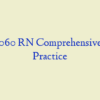Description
NSG 6440 Week 9 Practice Exam
- Which of the following is a primary prevention measure for a 76-year-old man newly diagnosed with a testosterone deficiency?
- Which of the following is an example of secondary prevention in a 50-year-old woman?
- Which of the following is an example of tertiary prevention in a patient with chronic renal failure?
- Nursing research should be utilized by:
- A clinical guideline may be found useful if the guideline was:
- Practice guidelines are designed to:
- Tatiana is receiving a sports physical to participate in cross-country running. She receives her exam from a single provider, who is examining all of the athletes one after the other in the nurse’s office at school. Which of the following is a problem with this exam format for sports physicals?
- Tyler is a 16-year-old football player who has an appointment for his sports physical. He had a head hit yesterday while playing with friends and went to the emergency room. He was discharged with a diagnosis of a concussion. Today he feels dizzy, has noise sensitivity and had trouble sleeping last night. Which of the following options is best for the clinician to pursue?
- The clinician is seeing Dahlia, a 15-year-old swimmer, for sports physical. During the examination, she notes she has had difficulty breathing while swimming over the last 3 days. Which of the following options is best for the clinician to pursue?
- Which theory regarding the aging process is linked to cancer and Alzheimer’s disease?
- What is the key to increasing physical activity in older adults?
- Which of the following is especially important for ensuring the safety of older adults?
- Which of the following would be a cause of neuropathic pain?
- Which drug is considered the MOST effective medication for pain in terminally ill patients?
- Unlike palliative care, hospice provides:
- How often should clinicians reassess a patient that is on chronic opioids?
- You are providing end-of-life care to an elderly patient with a history of heart failure. The patient complains of dyspnea. What is often the first-line treatment for this condition?
- The cost of care provided by an APRN is approximate:
- How do bundled payments differ from fee-for-service or global capitation?
- Patients require education prior to accessing health-care services for the following reason:
- Accounting keeps track of the financial state of a business. The accounting report that demonstrates the net-growth in assets is:
- Commonalities among psychotherapeutic techniques include the following:
- The goals of the 15-minute hour approach include:
- BATHEing the patient refers to:
- Which of the following scenarios best demonstrates the relationship between physical health and distress?
- Which type of liability insurance covers only situations in which the incident occurred and the claim was made while the policy was in effect?
- Which insurance plan was the first to allow members to choose nurse practitioners as their primary-care provider and pay them the same rate as physicians for the same care?
- In the model for future Advanced Practice Registered Nurse (APRN) practice, what does the “C” of LACE represent?
- What principle is most important when obtaining informed consent?
- Emotional intelligence is defined as:
- Qualities associated with resilience include:
- According to nurse theorist Jean Watson, a focus on positive intentionality—holding caring thoughts, loving kindness, and open receptivity—enhances caring energy, which leads to healing. How can the APRN bring this to their practice?
- Billy presents with edematous and erythematous lid margins and closer visual inspection with a Wood’s lamp reveals scaling. Which of the following conditions could be the diagnosis?
- Which of the following is true about epiphora?
- The clinician is seeing a patient complaining of red eye. The clinician suspects conjunctivitis. The presence of mucopurulent discharge suggests which type of conjunctivitis?
- Which is appropriate patient education to provide regarding bacterial conjunctivitis?
- With regards to the relationship between diabetes and diabetic retinopathy, which of the following is TRUE?
- Who of the following is a patient with risk factors for macular degeneration?
- Which of the following is an example of sensorineural hearing loss?
- In which of the following scenarios would otitis media (OM) be considered chronic?
- Which of the following treatments is appropriate for a patient who has acute otitis media and has an allergy to penicillin?
- Fluctuations and reductions in estrogen may be a contributing factor in which type of rhinitis?
- Which type of stomatitis is caused by continual exposure to chewing tobacco?
- The presence of hairy leukoplakia in a person with no other symptoms of immune suppression is strongly suggestive of which type of infection?
- Which of the following medications is safe to use when an adult patient has a perforated tympanic membrane?
- Betty presents with tenderness on traction of the pinna in her right ear and when the provider places pressure on her right tragus, she expresses she is in pain. The clinician does not suspect a tympanic membrane rupture, but would like to make Betty more comfortable during the exam. Which of the following solutions should the clinician administer before attempting an examination?
- A patient has dysphonia ?3 days as a result of a viral illness. Which of the following educational points is correct?
- Which of the following medications for temporomandibular disorder has the warning that patients should NOT drive while taking it?
- What is the initial treatment for uncomplicated anterior epistaxis?
- Based on these patients’ histories, which of the following should receive fungal serology testing for their chronic cough?
- Which of these patients should be given a decongestant?
- Annie is a 30-year-old African American woman that complains of “coughing up blood.”and SOB when lying down or during excertion What is a likely cause of her condition?
- African American patients seem to have a negative reaction to which of the following asthma medications?
- Why do you suspect that your patient may have a decreased response to the tuberculin skin test (TST)?
- Which information should be included when you are teaching your patient about the use of nicotine gum?
- George has COPD and an 80% forced expiratory volume in 1 second. How would you classify the severity of his COPD?
- Which of the following patients would you expect to have a decreased response to TST?
- Which of the following is a possible consequence of sleep apnea?
- Which of the following statements regarding pulmonary function and cigarette smoking is true?
- Which of these patients should be evaluated with serum alpha-antitrypsin levels?
- A blood pressure (BP) of 150/90 is considered:
- Lifestyle modifications to manage hypertension (HTN) include:
- You are assessing Sigred for metabolic syndrome. Which of her parameters is indicative of this syndrome?
- Which type of angina do you suspect in Harvey, who complains of chest pain that occurs during sleep and most often in the early morning hours?
- A patient is undergoing a cardiac stress test. Which of the following parts of their history could cause a false-positive reading?
- Which of these patients is at a higher risk for developing deep vein thrombosis?
- What percentage of patients with angina pectoris will have simultaneous dyspnea, caused by transient increase in pulmonary venous pressures that accompany ventricular stiffening during an episode of myocardial ischemia?
- Which of the following patient complaints indicates palpitations are due to increased catecholamine production?
- When teaching post-MI patients about their NTG tablets, the clinician should stress that the tablets should remain in the light-resistant bottle in which they are packaged and should not be put in another pill box or remain in areas that are or could become warm and humid. Once opened, the bottle must be dated and discarded after how many months?
- Which of the following doses of statins decrease LDL by up to 50% on average?
- What is true regarding the treatment of cilostazol?
- What value on the ankle-brachial index diagnoses peripheral artery disease?
- Your patient with permanent atrial fibrillation asks what other options he has to warfarin. You tell him:
- A patient comes to the office complaining of constipation. The patient lists all of the following medications. Which drug could be responsible for the constipation?
- A patient is seen with complaints of diarrhea. Which of the following should be included in the patient’s differential diagnosis?
- Cameron, 38 years old, is 5 feet 8 inches tall and weighs 189 pounds. He reports that he has had intermittent heartburn for several months and takes antacids with temporary relief. He has been waking during the night with a burning sensation in his chest. Which additional information would lead you to believe that gastroesophageal reflux disease (GERD) is the cause of his pain?
- Hannah is a patient that just had an appendectomy after a diagnosis of appendicitis and had no complications. Which of the following patient education points is correct?
- Which of the following is true of appendicitis?
- A 28-year-old patient is seen in the clinic with colicky abdominal pain, particularly after meals. She has frequent constipation, flatulence, and abdominal distension. Which of the data make a diagnosis of diverticulitis unlikely?
- A 28-year-old patient is seen with complaints of diarrhea. Which of the following responses to the history questions would help the primary-care provider (PCP) establish the diagnosis of irritable bowel syndrome (IBS)?
- Elaine is a 32-year-old Hispanic woman who is 33 weeks pregnant. She complains that when she wipes after defecation she noticed “a red streak on the toilet paper.” Which of the following should be included in the differential diagnosis?
- The nurse practitioner (NP) suspects a patient has a peptic ulcer. Which of the following items on the history would lead the NP to this conclusion?
- Which of the following is part of the treatment plan for the patient with IBS?
- Which type of heat-related illness involves a core body temperature of at least 104°F and may present with hot dry skin, acute mental status changes, absent sweat, and tachypnea?
- Which drug commonly prescribed for burns is active against a wide spectrum of microbial pathogens and is the most frequently used agent for partial- and full-thickness thermal injuries?
- What number represents normal neurological function on the Glasgow Coma Scale?
- Delayed serum sickness–type reactions in response to multiple bee, wasp, or fire-ant stings can be managed with which of the following?
- A patient who sustains blunt chest trauma and/or penetrating chest trauma must have which of the following imaging examinations?
- What is the most common cause of infectious conjunctivitis?
- Which of the following indicates a diagnosis of dementia?
- Which of the following may trigger migraines?
- Sondra’s peripheral vestibular disease causes dizziness and vertigo. Which of the following medications will help to decrease edema in the labyrinth of the ear?
- Which of the following signs would a health-care provider expect to see in a patient with Parkinson-plus disorder?
- Which of the following is a sign or symptom of a migraine?
- Which of the following describes a bulla?
- An example of ecchymosis is:
- Your patient is in her second trimester of pregnancy and has a yeast infection. Which of the following is the most appropriate treatment?
- Jeffrey has atopic dermatitis. You are prescribing a low-dose topical corticosteroid for him. Which would be a good choice?
- Jack is complaining of an extremely pruritic lesion that is round to a half circle in his genital area. Which of the following is the most likely diagnosis?
- Which of the following is true of scabies?



